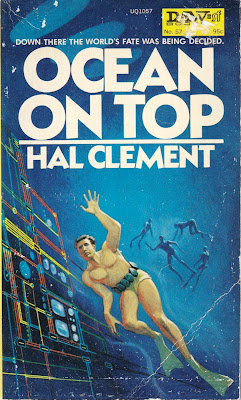2 / 5 Stars
‘Ocean on Top’ (141 pp.) is DAW Book No. 57, and was published in June 1973. The cover artwork is by Jack Gaughan. The story first appeared as a serial in 1967 in Worlds of If.
‘Ocean’ is the first effort I’ve made since September 1974 to read a Hal Clement novel.
Back in ’74, I purchased the Del Rey paperback edition of 'Cycle of Fire', got about 25 pages into it, and gave up on it. It was one of the most boring books I’d ever attempted to read.
I decided to give’ Ocean’ a try mainly because of its brevity.
‘Ocean’ is set not too far in a future in which the Earth is ruled by one government, the result of various crises caused by overpopulation and dwindling energy reserves. The primary agency in this World Government is the Power Board, which is responsible for creating, distributing, and monitoring energy throughout the planet.
Energy budgets are tight, and whenever it appears that someone - or something - is taking more than their allotted share of electrical power, the Board promptly dispatches an investigative team.
As the novel begins, the un-named first-person narrator (later on, we learn one of his nicknames is ‘Tummy’) is descending the Pacific near Tahiti, in a futuristic bathysphere. Our hero is investigating the previous descents, and disappearances, of three Power Board colleagues. It seems that there are impressive power readings emanating from the ocean floor far below, and the Board wants a closer look.
Tummy’s bathysphere is carefully concealed within the wreckage of a ship, so as not to alert any potential adversaries lurking on the ocean bottom. Once he touches down he is astonished to see fields of lights, hanging suspended from the sea floor, and below the lights, what seems to be an enormous tarp, constructed of some unique, quasi-transparent fabric.
Before long, divers come to view the wreckage. But ‘Tummy’ is astounded, for despite the fact that the sea bed is 5,000 feet down, the divers are wearing simple helmets, coveralls, and no breathing apparatus. By all rights they should have been instantly crushed to pulp by the tremendous pressure of the ocean above them.
What is going on here, in what should be the barren, perpetual darkness of the ocean floor ? Is this mysterious facility tied into the disappearance of the three Power Board members ?
Tummy will need to find out, and soon, because his bathysphere has a limited amount of air…..and the divers are taking a much closer look at the wreckage that camouflages his craft………
I got through 'Ocean' in its entirety. Like most (all ?) of Clement’s novels, the narrative is dominated by hard sf themes. There are extended, rather pedantic, segments in which the narrator elaborates on the mechanics and physics of living and working on the ocean floor. The dialogue can be wooden at times, and the plotting is merely a scaffold upon which the science can be expounded.
Compared to other sf of the era, ‘Ocean’ is devoid of much in the way of real suspense or dramatic tension. Towards the end of the novel the author introduces some interpersonal conflicts, but these seem like very contrived efforts to give the narrative some sort of impetus.
In summary, ‘Ocean On Top’ is a readable, if not particularly exciting, novel. Clement fans will want to have a copy, but others won’t miss much if they decide to pass on it.






.jpg)



















No comments:
Post a Comment